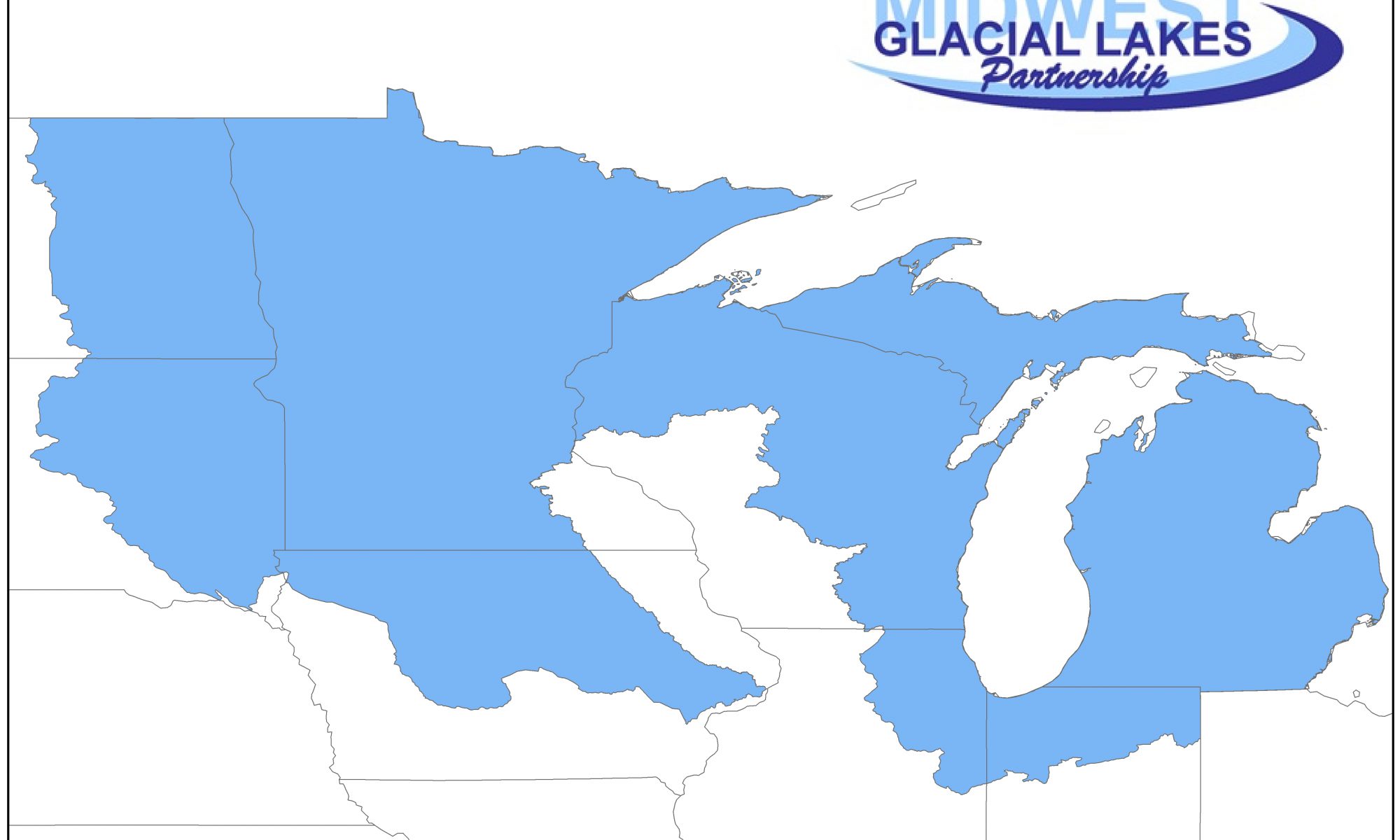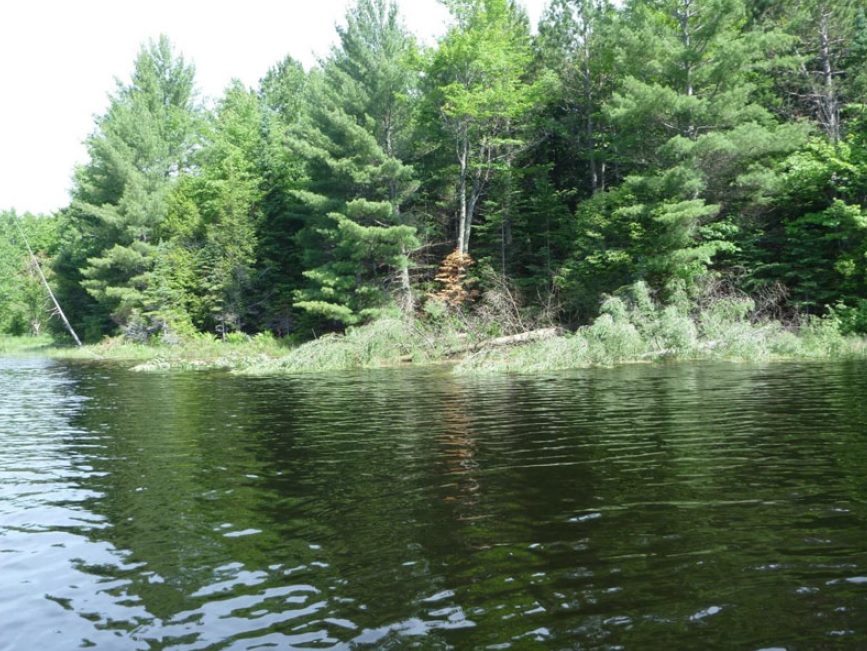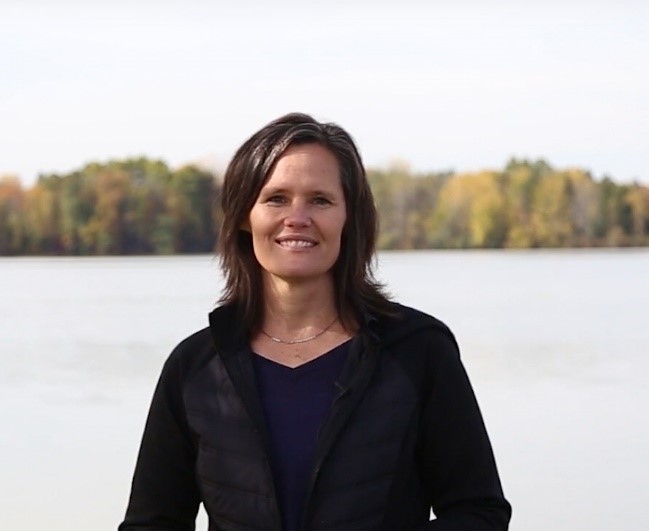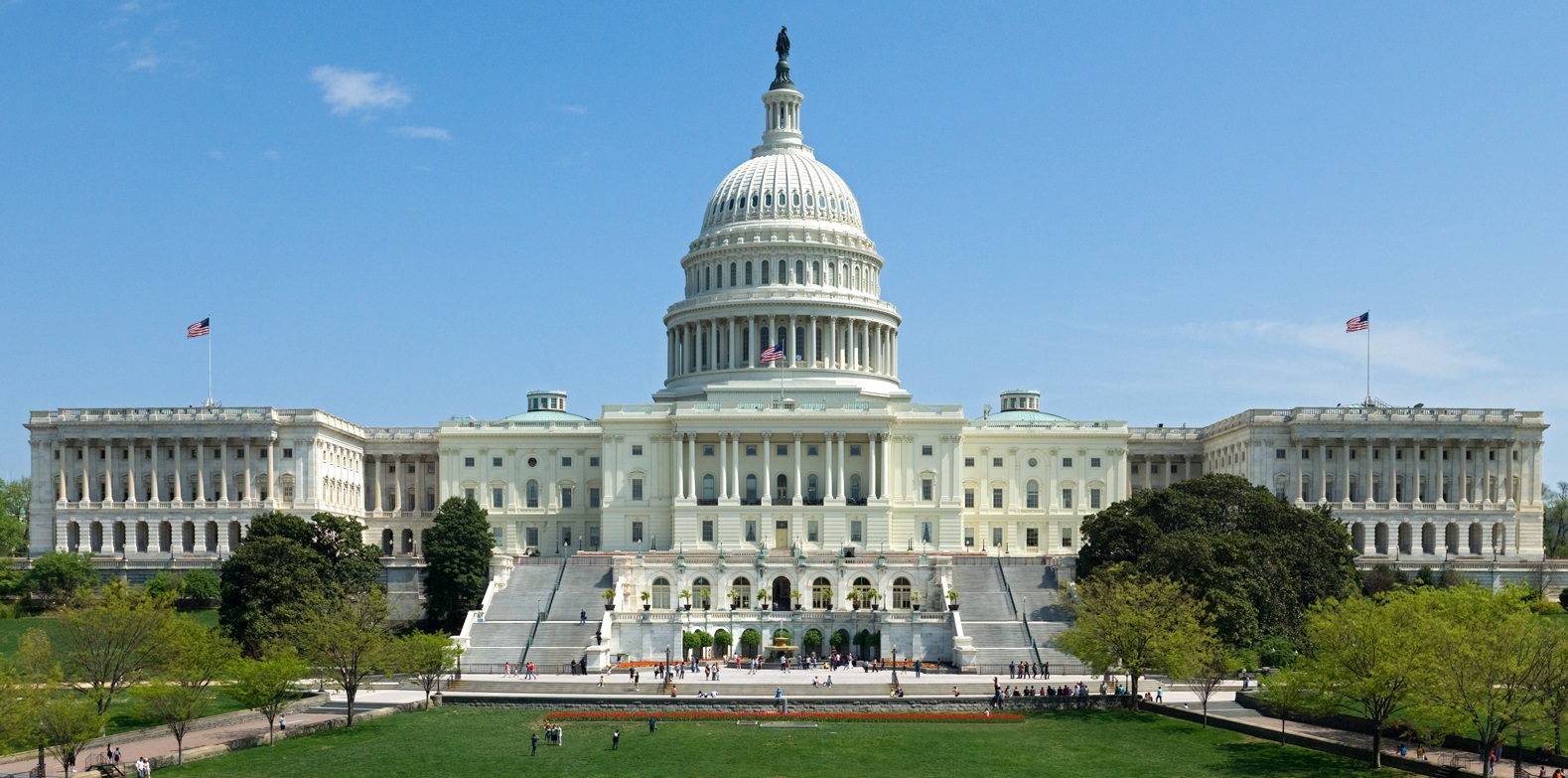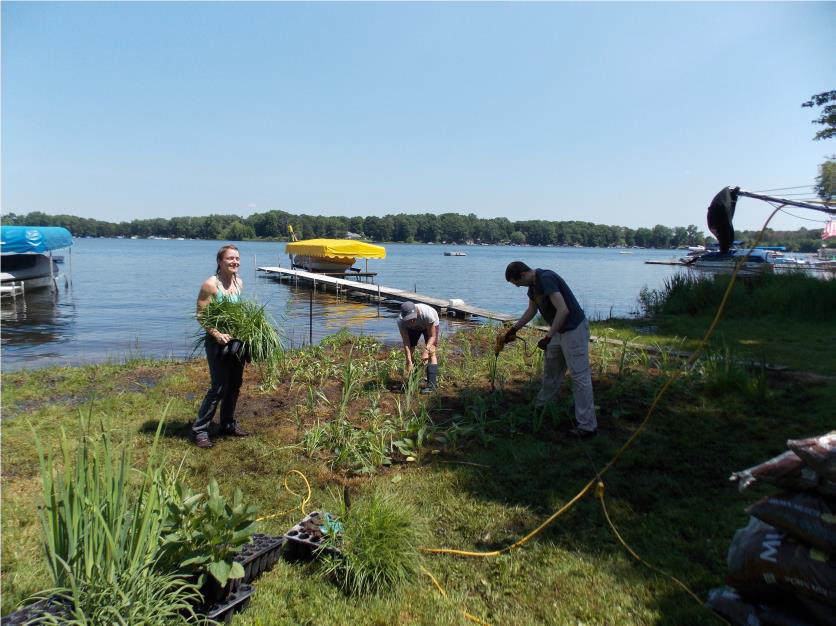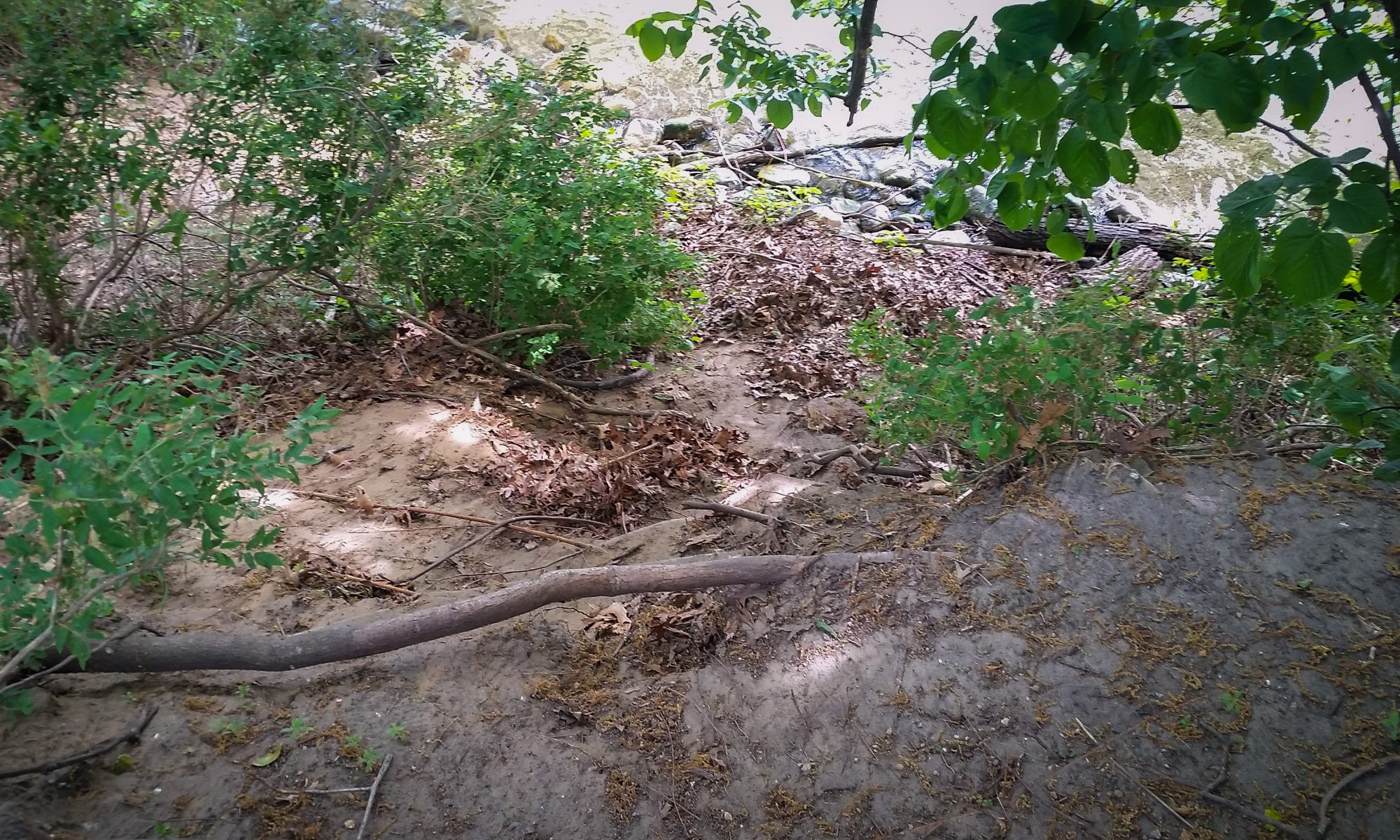The Midwest Glacial Lakes Partnership (MGLP) is announcing its annual request for fish habitat conservation project proposals (APPLY HERE). We support conservation projects that work toward meeting the goals and objectives set forth in the MGLP Strategic Plan to benefit glacial lake fish habitats, which include addressing the chemical, physical, and biological components of the habitats that fishes found in glacial lakes use throughout their lives.
READ MOREManagement Spotlight: Scientific advances and adaptation strategies for Wisconsin lakes facing climate change
Climate change is expected to affect fish habitat in our lakes, but on an issue where international agreements are the gold standard, it can seem overwhelming for state-, local-, and lake-based organizations. To address the challenge, stakeholders in Wisconsin recently met to identify scientific advances and adaptation strategies that they could employ on their lakes. The group convened at the Wisconsin Initiative on Climate Change Impacts lake adaptation workshop in 2018, and recently released the results of their work. Their publication will be part of a Midwest Glacial Lakes Partnership-organized issue in the journal Lake and Reservoir Management focusing on managing fish habitat and fisheries affected by habitat.
Continue reading “Management Spotlight: Scientific advances and adaptation strategies for Wisconsin lakes facing climate change”Research Spotlight: Coarse Woody Habitat in Inland Lakes
Anglers know that to catch many fish species, they should target their fishing near coarse woody habitat such as fallen trees. Fish seem to congregate there, so they must be good for fish populations, right? Greg Sass and others reviewed the literature on coarse woody habitat in inland lakes and introduced a novel study that will help to provide new insights. Their publication will be part of a Midwest Glacial Lakes Partnership-organized issue in the journal Lake and Reservoir Management focusing on managing fish habitat and fisheries affected by habitat.
Continue reading “Research Spotlight: Coarse Woody Habitat in Inland Lakes”Lake Conservation Webinar Series: Michigan Shoreland Stewards Program
In the next Midwest Glacial Lakes Partnership (MGLP) Lake Conservation Webinar, learn how Michigan is helping lake front property owners to determine if they are managing their property in a way that is healthy for their lake through the MI Shoreland Stewards Program. Julia Kirkwood with the Michigan Department of Environment, Great Lakes and Energy will explain what the program is and how the online survey works. Lakefront property owners are provided with a rating of Gold, Silver, Bronze or Starter level along with recommendations for improvement.
Continue reading “Lake Conservation Webinar Series: Michigan Shoreland Stewards Program”Announcement: MGLP Conservation Planner released
The Midwest Glacial Lakes Partnership (MGLP) is excited to release its new MGLP Conservation Planner, which provides lake data to inform communication, management, and research to benefit fish habitat and lake ecosystems. Specifically, the MGLP Conservation Planner provides data on likely suitability for fishes, land cover along the shoreline and in the lake’s watershed, and conservation recommendations to supplement existing information for each lake. Its recommended uses include provision of data to inform single-lake management, establishment of a framework for conservation strategies in each lake, identification of patterns in fish habitat due to climate and land use change, and as a supplement during potential prioritization of limited resources among lakes. Learn how to use the Conservation Planner by attending this webinar live on May 15th or afterward in the archive of MGLP Lake Conservation webinars.
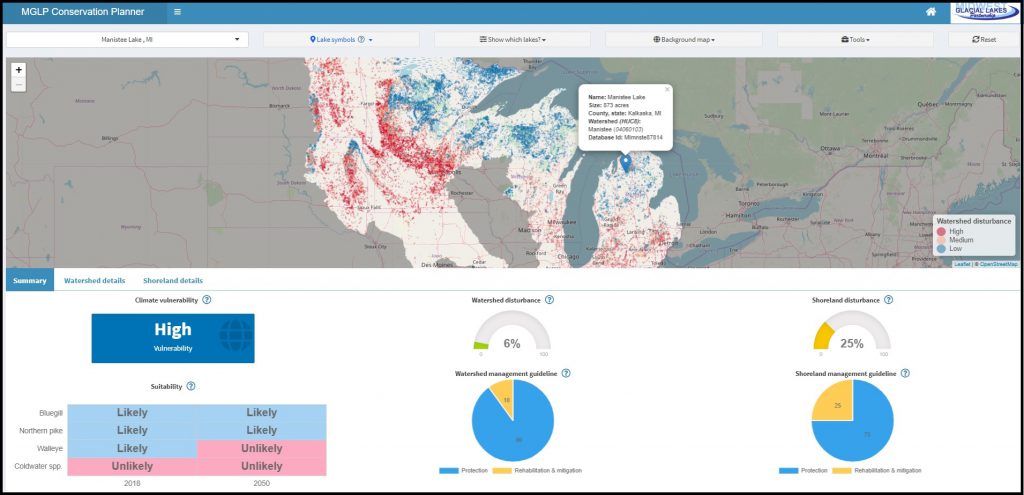
The MGLP Conservation Planner provides data on the ~40,000 inland lakes over 10 acres within the Midwest Glacial Lakes Partnership’s 8-state footprint. For fish habitat suitability data, we developed species distribution models that predict the presence or absence of a species using a suite of variables describing lake temperature, morphology, hydrology, and connectivity. These models were used to estimate whether each lake was likely to support representative warmwater (Bluegill), coolwater (Northern Pike and Walleye), and coldwater (any coldwater species including Cisco, Lake Whitefish, Lake Trout, and Burbot) fishes. These models were applied using current (2018) and future (2050) climate scenarios to assess changes in fish habitat suitability.
We delineated lake watersheds and assessed disturbances in the watershed using information from the 2006 National Land Cover Database. In general, urban and agricultural land cover increase sediment and nutrient inputs to lakes as a result of runoff, sewage, leaking septic systems, and other sources. We delineated each lake’s watershed and report watershed disturbance as the proportion of the watershed area with urban or agricultural land cover.
“We’re really excited, and are looking forward to using the tool to help build Wisconsin’s healthy waters program to protect lake water quality and fish habitat,” says Pamela Toshner, a Lake & Watershed Protection Specialist with the Wisconsin Department of Natural Resources.
We also delineated shorelands as the area within 100m of each lake and assessed disturbances to the shoreland using information from the 2006 National Land Cover Database. We report shoreland disturbance as the proportion of the shoreland area with urban or agricultural land cover. Shorelands provide habitat for fish and wildlife species, influence the movement of nutrients and woody debris, and affect soil erosion along the lake shore. Human development within shorelands often results in decreased aquatic vegetation and large woody habitat, hardening of the shoreline, reduction in water quality, and declines in fish and wildlife populations.
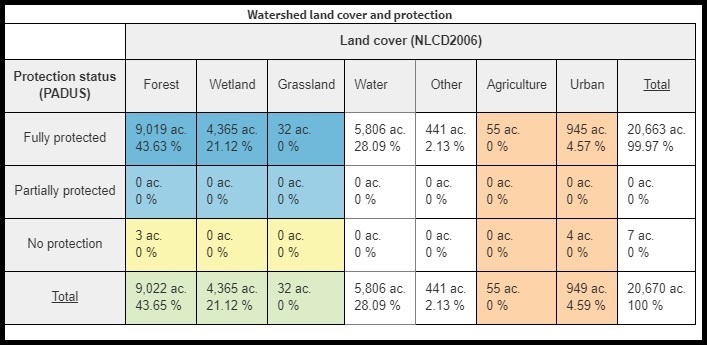
We recommend tailoring shoreland and watershed management strategies to existing land use and land cover. We distinguish between two strategies for shoreland and watershed conservation, and provide general guidance regarding the recommended distribution of effort toward protection versus rehabilitation and mitigation based on the condition of these areas summarized for each lake. This guidance is based off of a review of the literature, feedback from a focus group of stakeholders, and consensus from the MGLP Science and Data Team. The most efficient strategy is protecting land. Examples of protection include acquisition, easement, zoning, invasive species protection, and monitoring. In some cases, critical habitats or land have been degraded; rehabilitating and mitigating this degradation is often more expensive and does not provide all of the ecosystem functions that an undisturbed ecosystem would provide. Examples of rehabilitation include reforestation, creation of vegetated buffer strips, building engineered wetlands or stormwater retention ponds, bioengineered shorelands, and addition of large woody habitat. Examples of mitigation include using best practices for fish passage on road-stream crossings, erosion control measures, and minimizing sewage and runoff.
The MGLP Conservation Planner is the culmination of a ten-year effort by scientists and managers within the partnership. The Science and Data Team collected data from state, federal, and tribal partners to conduct its fish habitat analyses, and developed the Conservation Planner based on these results. The Conservation Planner was targeted at needs identified by a survey of MGLP Partners and was evaluated for iterative improvements by a dedicated focus group and over 40 committee members within the partnership. We plan to update the MGLP Conservation Planner based on user feedback and new data. Your feedback is welcome; please contact MGLP Coordinator Joe Nohner with comments or questions.
The MGLP brings together resource agencies, non-profit organizations, and other stakeholders to protect, rehabilitate, and enhance sustainable fish habitats on naturally formed (glacial) lakes of the Midwest. We foster collaborations on fish habitat science, education and outreach, and conservation. For more information, please follow us on Twitter or reach out to our coordinator, Joe Nohner. If you are not already on our newsletter email list, please SIGN UP NOW to learn about MGLP activities including our annual request for grant proposals coming in August.
Support the National Fish Habitat Conservation Through Partnerships Act
 The bipartisan National Fish Habitat Conservation Through Partnerships Act, which would greatly benefit the MGLP, was recently introduced in the House and Senate. The MGLP asks you to consider supporting these bills through your organization if possible, writing your representatives personally, and sharing information on the bills to those that may be interested.
The bipartisan National Fish Habitat Conservation Through Partnerships Act, which would greatly benefit the MGLP, was recently introduced in the House and Senate. The MGLP asks you to consider supporting these bills through your organization if possible, writing your representatives personally, and sharing information on the bills to those that may be interested.
Project spotlight: Mitigating septic discharge with riparian vegetation
Written by Mark S. Kieser
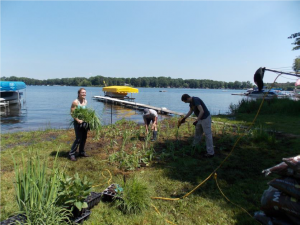
The Midwest Glacial Lakes Partnership awarded the Eagle Lake Paw Paw Association (ELPPA) a grant in 2017 to test whether naturalized shorelines and deep-rooted shoreline vegetation can mitigate septic system contaminant and bacterial discharges to lakes. Over the past year, Kieser & Associates (K&A) has been working with the ELPPA to test seven ‘front yards’ around the lakeshore to determine how small patches of native plants grown between septic system drain fields and the water’s edge may protect water quality.
K&A is monitoring shallow groundwater at three of these sites to determine how deep-rooted plants may help prevent nutrients and bacteria from reaching the lake. They are also monitoring how these small, but potentially important, plantings may help improve fish and aquatic habitat along the lakeshore.
Test sites have been established to test groundwater both with and without native plantings. Differences in nutrient and bacteria concentrations will be used to determine whether there are real benefits with this innovative approach compared to much higher cost solutions of septic system replacement or sewering. This effort will help determine whether a simple patch of native landscaping along a residential shoreline can become an inexpensive way of mitigating this national problem of older systems contributing to water quality problems, impairing aquatic habitat and diminishing property values.
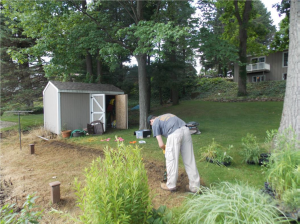
Six groundwater monitoring wells were installed at each of the three groundwater monitoring test sites in April of 2018. These were placed upgradient, downgradient and cross-gradient of septic drain fields. Two rounds of semi-annual groundwater sampling have already been conducted. Samples were submitted for analysis of soluble reactive phosphorus, nitrate nitrogen, ammonia nitrogen, total dissolved solids, chloride, and E. coli bacteria.
Nearshore macroinvertebrate sampling was conducted in May 2018 to serve as baseline conditions prior to natural shoreline installations. Samples were collected in front of each of the seven project sites, three of these also serving as groundwater monitoring sites. In July of 2018, a variety of deep-rooted native plants, co-selected with residents, were planted at four project sites, one of these with groundwater monitoring wells.
The project is scheduled to be completed in 2019 although the ELPPA may continue to support longer-term monitoring to maximize benefits of the current efforts. These data will help determine whether this technique is viable, cost-effective, and scalable approach to address septic system discharges to lakes and streams. The MGLP will share the results of this project through future newsletters.
Lake conservation webinars and reports
We want to share our partners’ efforts to address fish habitat conservation challenges. If you have a webinar, study, or report that you feel should be shared with the partnership, please send it to MGLP Coordinator Joe Nohner, and we will consider including it in future communications. Here are two webinars that may be of interest.
Variable Warming in Lakes of the Upper Midwest and Implications for Sport Fish
When: April 16 at 1 pm CST/2PM EST
Summary: Climate change is predicted to alter sport fish communities in Midwestern lakes, but managers currently have limited information on individual lakes that can be used to set local expectations or intervene with mitigation strategies. With strong participation from the Midwest Glacial Lakes Partnership, Northeast and North Central CASC supported researchers have combined existing fish and water temperature observations to build models that estimate daily water temperatures and fish habitat metrics for thousands of lakes in North Dakota, South Dakota, Minnesota, Wisconsin, Iowa, Michigan, and Indiana. This presentation will discuss key findings from several studies, including fishery responses to warming and variability in sensitivity to warming across lakes. It will also cover the use of data visualization to reach the general public and managers with the results.
2018 AFWA Climate Adaptation Surveys
When: May 1st at 12 pm CT
Register: https://zoom.us/meeting/register/8e27c165b60bcfe6d746f627e8486654
Summary: The results of the 2018 AFWA Climate Adaptation Surveys are in! The Surveys provide insight into state agency activities and needs for fish and wildlife management in a changing climate and helps to identify national-level priorities for advancing the National Fish, Wildlife, and Plants Climate Adaptation Strategy. The webinar will cover barriers to implementation, where States are accessing information, state research needs & priorities, survey trends, and major takeaways & recommendations. This is an opportunity for state and federal agency staff and other collaborative partners to get a glimpse at what states are doing to advance climate adaptation for fish and wildlife and how we can coordinate and prioritize our work as a community to be more effective.
$270,000+ in fish habitat conservation grants awarded by the MGLP
Today, the Midwest Glacial Lakes Partnership (MGLP) announced over $270,000 in grants funding fish habitat science, outreach, and on-the-ground conservation. The MGLP operates an annual grant program through the National Fish Habitat Partnership, whereby it directs dedicated funding from the US Fish and Wildlife Service to recipients that the MGLP identifies. See the project descriptions below to learn a little more about the work we’re funding. We’ll announce our request for fiscal year 2019 proposals in August using our email list; sign up if you have not already!
Promoting Bioengineering Options for Erosion Control on Michigan Inland Lakes – Tip of the Mitt Watershed Council
The Tip of the Mitt Watershed Council in Michigan will work in partnership with state agency staff and natural shoreline practitioners to develop two documents for practitioners summarizing bioengineering erosion control design options. The first document will provide information on bioengineering across the spectrum of wave and ice energy that a shoreline experiences, and the second document will focus specifically on high-energy shorelines. The information will also be promoted through a webinar that will be advertised to partners via the MGLP newsletter.
Lake Carlos fish passage project – Minnesota Department of Natural Resources
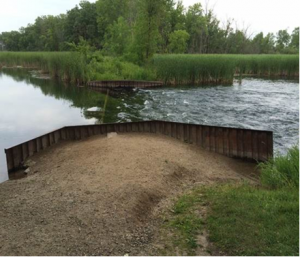
A dam at the outlet of Lake Carlos to the Long Prairie River currently blocks fish such as Walleye, Northern Pike, and multiple sucker species from entering the lake. This project will enable fish passage by installing a rock arch ramp at the site of the dam. The project will also benefit the rare Creek Heelsplitter and Black Sandshell mussels by providing access to habitat in Lake Carlos tributaries.
Assessment of oxythermal habitat of Cisco in Minnesota lakes for prioritizing habitat protection efforts – Minnesota Department of Natural Resources
Species such as Walleye, Lake Trout, and Cisco rely on cold, well-oxygenated water to grow and survive, yet climate and land use change threaten these habitat types. Rising annual air temperatures are resulting in warmer lakes, and nutrients from disturbed land reduce oxygen available for fishes. How these long-term patterns affect fishes is difficult to predict and changes throughout the season. This project will assess water temperature and dissolved oxygen continuously throughout the summer in six Minnesota lakes. It will help develop understanding of how precipitation and other short-term events affect fish habitat in combination with climate change and water quality threats facing lakes across the MGLP, so that habitat conservation efforts can be prioritized.
Assessment of critical thermal fish habitat in Midwest Glacial Lakes Fish Habitat Partnership lakes (Phase II) – United States Geological Service
Changing climates are expected to dramatically affect fish throughout the MGLP, and the first step in predicting the magnitude of these effects is to understand past and current water temperatures that create thermal fish habitat. This project will gather existing water temperature, oxygen, and water quality data in North Dakota, South Dakota, and Iowa and use this information to create statistical models of these variables to predict past, current, and future thermal fish habitat throughout the MGLP. This project builds upon data being gathered in Phase I for Minnesota, Wisconsin, Michigan, and Indiana.
Reconnecting Mason Creek to Duck Lake Restoration Project – Conservation Resource Alliance
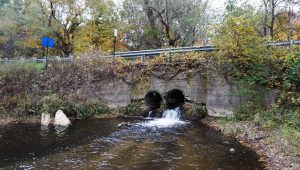
Mason Creek drains into Duck Lake, MI, but fish in the creek are not able to migrate to and from the lake due to perched culverts at a road crossing. This project will remove the culverts and replace them with a bottomless structure that allows for fish passage. Over 8 miles of habitat will be made accessible to fish in 1,930-acre Duck Lake and 5 tons of sediment will be prevented from entering Duck Lake due to the road-stream crossing.
Building capacity for Midwest Glacial Lakes Partnership conservation – Michigan Department of Natural Resources
This project will support the MGLP’s mission of fish habitat assessment and conservation implementation in glacial lakes of the Midwest by addressing basic database management needs. Specifically, the MGLP will 1) collect existing data from partners to update datasets and fill gaps in the database to support future assessments and 2) update of existing GIS data layers for use by the MGLP. These actions will help the MGLP to better assess fish habitat threats and conditions through its assessment and web viewer, thereby improving efficiency and efficacy of projects funded by the MGLP.
Partners meet to build and improve MGLP lake assessment web viewer

Way back in 2009, the MGLP identified the need to conduct an assessment of all ~40,000 lakes in its footprint to inform fish habitat conservation. Partners recognized the need to tailor their actions to each lake and to prioritize their actions given the limited amounts of funding and resources. Almost ten years later, following multiple iterations, countless meetings, and feedback from partners, the MGLP is finalizing the assessment and building a web viewer for partners to use it in their work.
The assessment is a product of the MGLP’s Science and Data Team, who contributed their own time to bring it together. The assessment predicts the presence or absence of four species of fishes representing temperature guilds, and uses climate change and land use change information to assess threats in the shoreland surrounding the lake and in the watershed. The team took great care to ensure that these efforts were beneficial to fisheries managers, conservation organizations, and other practitioners. After repeated rounds of feedback from the MGLP Steering Committee, the team conducted a survey this March of almost 400 MGLP partners to learn about their information needs and uses for the assessment. The team developed a draft web viewer based on that feedback, and in June the team conducted a 2-day workshop in Minnesota to gather even more input on questions such as “Could you use this tool with little training or GIS experience?” and “What information could you use from such a tool to assist your fish habitat conservation efforts?” Feedback from the workshop is helping the team to tailor information to meet practitioners’ needs.

For example, the assessment and web viewer will help practitioners identify specific sets of conservation actions based on the unique set of threats facing each lake. Whether their backgrounds were in outreach and education, land acquisition, fisheries management, or habitat grant administration, participants were excited to start using the assessment and web viewer. This was summed up in one of the anonymous feedback forms by a participant who wrote, “I look forward to seeing the next version of the tool, and ultimately using it for project prioritization, education and outreach, etc.”
The Science and Data Team is now implementing recommendations from the workshop to improve the web viewer, which it plans to release in the coming months. Stay tuned!
Inland lake fish habitat symposium provides management insight
 One of the Midwest Glacial Lakes Partnership’s primary objectives is to share science and management to improve and protect inland lake fish habitat across the region. Too often, boundaries between organizations become boundaries to information flow, and these boundaries hinder the ability of scientists, managers, and practitioners to accomplish their goals. An advantage of the Partnership is the opportunity to share experiences across organizations and learn from others. Through these conversations it became clear that there was a need for sharing recommendations for managing inland lake fish habitat. To address this issue, the Partnership organized a symposium at the 78th Midwest Fish and Wildlife Conference in Milwaukee, WI.
One of the Midwest Glacial Lakes Partnership’s primary objectives is to share science and management to improve and protect inland lake fish habitat across the region. Too often, boundaries between organizations become boundaries to information flow, and these boundaries hinder the ability of scientists, managers, and practitioners to accomplish their goals. An advantage of the Partnership is the opportunity to share experiences across organizations and learn from others. Through these conversations it became clear that there was a need for sharing recommendations for managing inland lake fish habitat. To address this issue, the Partnership organized a symposium at the 78th Midwest Fish and Wildlife Conference in Milwaukee, WI.
The “Managing fish habitat and fisheries affected by habitat in inland glacial lakes” symposium hosted ten speakers, each of which presented a review of current research and management on an important information gap below.
- Joe Nohner and coauthors discussed the benefits of using landscape ecological approaches to prioritize and inform lake management, using the Midwest Glacial Lakes Partnerships’ upcoming Phase II Assessment of Inland Lake Fish Habitats as an example of how such an approach could be implemented.
- Catherine Hein reviewed literature and field-experiences on efforts to prevent and/or reverse eutrophication, offering case studies to illustrate successful methods and avoid common pitfalls.
- Ralph Tingley and coauthors presented a framework for climate change adaptation in Midwest glacial lakes and highlighted strategies that have been implemented throughout the region.
- Nick Phelps identified the importance of understanding the environmental factors that contribute to fish kills and created models to predict future fish kills based on water temperature, primary productivity, human disturbance, and other factors.
- Jim Breck and coauthors presented models of bluegill growth based on landscape-scale drivers of fish habitat.
- Josh Raabe and coauthors reviewed the Walleye literature on how inland lake habitat may influence successful natural reproduction and stocking efforts and highlight remaining critical research questions.
- Greg Sass and coauthors presented research results from a series of coarse woody habitat additions and removals to inland lake littoral zones, highlighting issues related to production vs. attraction of fishes, the benefits of coarse woody habitat to different species, whether the effects of coarse woody habitat differ from fish cribs, and whether angler behavior and success are influenced by these habitats.
- Paul Radomski discussed techniques for aquatic plant inventory and monitoring, management options for aquatic plant protection, non-indigenous species control, and potential research opportunities to better understand aquatic plant and fish relationships.
- Jonathan Hansen provided a synopsis of aquatic plant management permitting in Minnesota, a program that balances the desires of lakeshore property owners and the need to conserve habitat for aquatic animals.
- Patrick Goggin and Pamela Toshner provided an overview of the Healthy Lakes Initiative in Wisconsin, whereby lakefront property owners are provided technical and financial assistance to implement specific best management practices to improve lake health.
The Midwest Glacial Lakes Partnership and authors associated with this symposium are currently pursuing publication options to share the information from this symposium broadly with project partners.
Crane Lake, MN project recognized by the National Fish Habitat Partnership “Waters to Watch” campaign
The National Fish Habitat Partnership has unveiled its annual list of “Waters to Watch”, a collection of rivers, streams, estuaries, lakes and watershed systems that will benefit from strategic conservation efforts to protect, restore or enhance their current condition. These voluntary, locally-driven projects represent some of the top conservation activities in progress implemented throughout the country by 20 regional Fish Habitat Partnerships, including the Midwest Glacial Lakes Partnership.
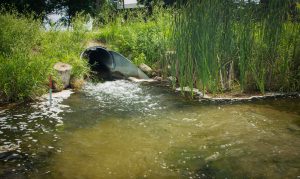
The Midwest Glacial Lakes Partnership is funding the replacement of an undersized and perched culvert at the outlet from Crane Lake with one that is more appropriately-sized, creating connectivity with waterbodies downstream. Minnesota DNR Fisheries Biologist Howard Fullhart explains that, “The undersized culvert creates high water velocities that fish can’t swim through, and when water flows are low, the culvert is perched and so fish aren’t able to pass. The new culvert will allow fish passage for walleye, northern pike, white suckers, darters, shiners, and other important fishes.” Crane Lake currently has lower populations than downstream lakes of migratory fish species such as walleye, white sucker, and weed shiner, a species of greatest conservation need in Minnesota’s State Wildlife Action Plan. The project is expected to increase fish community diversity and resiliency in Crane Lake by allowing fish to migrate into the lake. “This is a really neat project,” says Fullhart, “in that it was started by the local citizens who were concerned about fish passage and the road potentially washing out. County engineers, the Minnesota DNR, and the Midwest Glacial Lakes Partnership are all providing funding and resources to the project to benefit natural resources, transportation, and surrounding property owners.”
Conservation projects, such as the Crane Lake culvert replacement, benefit the Waters to Watch by conserving freshwater, estuarine and marine habitats essential to the many fish and wildlife species that call these areas home. These examples of conservation have been fundamental to the overall success of the National Fish Habitat Partnership since 2006.
Over time, these conservation efforts are reversing persistent declines in our nation’s aquatic habitats. Having featured over 100 partnership projects since 2007, these “Waters to Watch” are proving that science-based on-the-ground conservation efforts are truly making a difference in improving fish habitat across the United States.
“We are pleased to continue our Waters to Watch Campaign for the 11th year in 2017,” said Tom Champeau, Chair of the National Fish Habitat Board. “The “Waters to Watch” campaign is one of our best ways nationally to highlight the work of our 20 partnerships annually.”
People interested in learning more about the National Fish Habitat Partnership and partner projects happening across the U.S. can find out more information on how to get involved on our Partnerships Page; http://www.fishhabitat.org/the-partnerships/.
If individuals are interested in contributing to the work of the Midwest Glacial Lakes Partnership, a 501(c)3 organization names Beyond the Pond for this purpose. Donations can be made to the Midwest Glacial Lakes Partnership at the Beyond the Pond website.
Clear Lake, IN project receives funding with support from the Partnership
You may have heard that the Midwest Glacial Lakes Partnership funds habitat conservation through its grant, but did you know the Partnership catalyzes habitat conservation in other ways? With assistance from the Partnership, Clear Lake Township Land Conservancy in Indiana was recently granted an award from the FishAmerica Foundation supported in part by the Brunswick Public Foundation to complete its fish habitat conservation project .
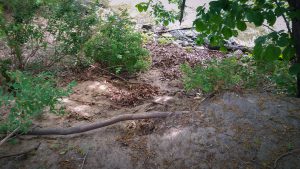
Residents, anglers, and lake recreationists on Clear Lake were concerned about the water quality of their aptly named lake. Erosion on a popular boating destination, Kasota Island Nature Preserve, was causing excess sediments and nutrients to enter the lake, which threatened to decrease water clarity and water quality. The Conservancy applied for the grants through the Midwest Glacial Lakes Partnership and Indiana Department of Natural Resources, but was looking for additional sources of funding. The Partnership shared the FishAmerica Foundation grant opportunity with the Conservancy, and wrote a letter of support on behalf of the project. As a result, the Conservancy acquired all of the funds it will need to install a bioengineered shoreline and complete its project!
“Collaboration on large scale projects is key for organizations as small as ours,” says Bridget Harrison, Executive Director for Clear Lake Township Land Conservancy. “We appreciate all of the partners helping to make this project possible and working with the Midwest Glacial Lakes Partnership has been wonderful. We appreciate their letter of support and endorsement of our project. The shoreline restoration project along Kasota Island Nature Preserve will not only improve water quality but it will ensure that the island is here for future generations by minimizing the current loss of 4 inches of shoreline per year. ”
The Midwest Glacial Lakes Partnership is happy to support projects that align with its mission to protect, rehabilitate, and enhance sustainable fish habitats in glacial lakes of the Midwest for the use and enjoyment of current and future generations. The partnership has written letters of support for research projects and on-the-ground habitat projects. If you have a project that needs support or a grant that needs to be distributed broadly, consider reaching out to Joe Nohner, Partnership Coordinator, for more information.
Fish habitat conservation funding announcement
The Midwest Glacial Lakes Partnership (MGLP) is happy to announce its request for fish habitat conservation proposals for funding. The MGLP consists of state, tribal, and federal natural resource agencies as well as multiple nongovernmental organizations, all focused on the goals of protecting, rehabilitating, and enhancing sustainable fish habitats in glacial lakes of the Midwest for the use and enjoyment of current and future generations.
The MGLP anticipates approximately $180,000 in funding will be available. Most projects have received between $20,000 and $70,000, but larger awards are possible. If you have an aquatic habitat conservation project aligned with the goals and objectives of the MGLP and need financial assistance, we encourage you to submit a proposal for project funding. An application for funding is included with this announcement, and you can submit your application by emailing it to MGLP Coordinator Joe Nohner at nohnerj@michigan.gov by October 15, 2017.
Learn more about how to apply for funding on our grant webpage.

